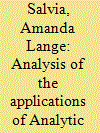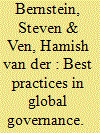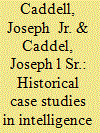|
|
|
Sort Order |
|
|
|
Items / Page
|
|
|
|
|
|
|
| Srl | Item |
| 1 |
ID:
167004


|
|
|
|
|
| Summary/Abstract |
In Brazil, the public lighting sector is a responsibility of the municipal government and typically represents around 4% of the electricity consumed by cities. Considering the significant importance and functions of this service, sustainable management is necessary. The aim of this paper is to investigate the main practices used worldwide in terms of energy efficiency of public lighting and propose the use of the multi-criteria method called Analytic Hierarchy Process to choose the best options for a group of Brazilian cities, namely Passo Fundo, Santa Maria and Porto Alegre. The methodology of this paper consists of searching for best practices in public lighting, which worked as alternatives for applying the Analytic Hierarchy Process. The final step consisted of presenting the impacts of a potential implementation, through analysis of energy and financial savings. The results suggest the preferred practices to each municipality (Audit and Guide Elaboration, Retrofit, Alternative Energy and Management) and their potential implementation can promote energy and financial savings up to 6 GWh/year and 600,000.00 US$/year. The main implications of this paper are related to proposing the use of a multi-criteria method to the public lighting sector and providing useful insights for local governments and especially for developing countries.
|
|
|
|
|
|
|
|
|
|
|
|
|
|
|
|
| 2 |
ID:
153261


|
|
|
|
|
| Summary/Abstract |
Best practices are increasingly used to govern a range of global issues. Yet, the rise of global governance through best practices has received scant attention in the International Relations literature. How do best practices differ from other modes of governance? How are they constructed? And to what end? We offer a novel conceptualisation of best practices as a unique mode of global governance principally distinguished by basing claims of political authority on existing practices. Belying their apolitical terminology, best practices in global governance are purposively constructed by political actors to steer targeted actors toward desired ends. We illustrate the characteristics of governance through best practices with reference to state and non-state global governance initiatives in a wide range of issue areas, ranging from finance and development to human rights and the environment, and through an in-depth case study of the ISEAL Alliance, a disseminator of best practices for transnational sustainability standard-setters. We find that governance through best practices has both positive and negative consequences. While it offers a pragmatic approach to global governance under conditions of fragmentation and polycentricity, it can also mask underlying power dynamics and political agendas and therefore requires ongoing critical scrutiny.
|
|
|
|
|
|
|
|
|
|
|
|
|
|
|
|
| 3 |
ID:
176504


|
|
|
|
|
| Summary/Abstract |
This article examines best practices in local ownership of Track Two diplomacy. Taking as a starting point the idea that best practices change over time as conflicts and social responses to them change, the article seeks out recent innovations and practices in Track Two diplomacy, focusing on practices of local ownership. A series of two reflective practice workshops with facilitators of Track Two processes offer insights on local ownership in current Track Two diplomacy. More in-depth examination of the Georgian-South Ossetian case illustrates an example of increasing local ownership developing over time during a ten year Track Two process. Together, the reflective practice workshops and the case study suggest team approaches to Track Two diplomacy so that insiders and outsiders work together as a team to facilitate, bringing the strengths of both insiders and outsiders to Track Two processes.
|
|
|
|
|
|
|
|
|
|
|
|
|
|
|
|
| 4 |
ID:
142448


|
|
|
|
|
| Summary/Abstract |
We can reform peace education to make it more effective, but teaching conflict transformation at a national level may be just as critical.
|
|
|
|
|
|
|
|
|
|
|
|
|
|
|
|
| 5 |
ID:
155211


|
|
|
|
|
| Summary/Abstract |
This paper identifies best practices for the selection and delivery of historical cases for use in intelligence studies education. These pedagogical imperatives (and avoidable pitfalls) apply to different levels of instruction and are relevant both for public and classified instruction. Drawing upon relevant social science scholarship on the use of historical case studies, the authors propose methods to select appropriate cases tailoured to achieve desired learning outcomes, to promote active learning and to avoid common problems such as hindsight bias, oversimplified single-narrative interpretations and prepackaged ‘lessons learned’ devoid of historical context.
|
|
|
|
|
|
|
|
|
|
|
|
|
|
|
|
| 6 |
ID:
176508


|
|
|
|
|
| Summary/Abstract |
The articles in this issue present a wide range of findings. First, the field continues to grapple with definitional issues: different types of projects aimed at different outcomes and audiences. More care needs to be given by each dialogue to define rigorously what it is trying to do and why. Second, fundamental lessons have emerged over the past six decades, which must be learned and observed by those active in this field, even as they seek to push the boundaries of theory and practice. Third, while it is generally agreed that the field must become more inclusive, both in terms of people and interests, and also in terms of encouraging local ownership and more transformative projects, a one-size-fits-all approach will not work; each dialogue should be viewed as unique. Finally, the field is a dynamic and evolving one. What seems to be best practice today may not be so tomorrow.
|
|
|
|
|
|
|
|
|
|
|
|
|
|
|
|
|
|
|
|
|